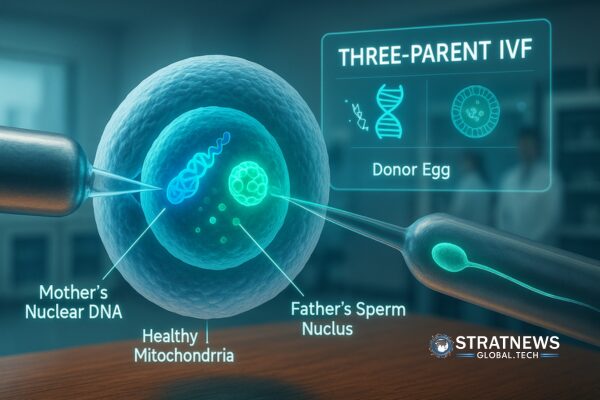UK’s New IVF Method Saves Eight Children from Genetic Disorders
Eight children in the UK have been saved from life-threatening genetic diseases, thanks to a pioneering IVF method developed at Newcastle University. Known as the three-person IVF technique, this procedure involves combining DNA from three people to prevent harmful genetic mutations from being passed to babies.
How the Three-Person IVF Technique Works
This innovative technique involves removing the mother’s egg nucleus and the father’s sperm nucleus after fertilisation. These nuclei, containing the child’s genetic material, are then inserted into a healthy donor egg that has had its own nucleus removed. The donor egg provides healthy mitochondria, which are the energy producers in cells. This step is crucial as faulty mitochondria can lead to severe health issues in organs like the heart, brain, muscles, and kidneys.
The result is a fertilised egg that combines the mother’s and father’s DNA with healthy mitochondria from the donor. The egg then develops into a healthy embryo, which doctors can implant into the mother.
Healthy Results and Long-Term Monitoring
So far, this method has led to the birth of eight healthy children. One child is now two years old, two others are between one and two years old, and five are still infants. According to the study in the New England Journal of Medicine, all were healthy at birth. Blood tests showed very low or no levels of the harmful mitochondrial mutations inherited from their mothers.
Development checks reveal that all children are growing normally. In most cases, their levels of mutated mitochondrial DNA were reduced by over 95%, providing significant protection from inherited diseases.
Out of 22 women treated using this method, eight have given birth, and one more is currently pregnant. Seven pregnancies were without complications, although one woman showed high blood lipid levels during pregnancy. Importantly, no miscarriages occurred during the trials.
Ethical Progress and Future Hopes
Dr. Andy Greenfield from the University of Oxford, not involved in the research, noted that this success follows decades of scientific, ethical, and regulatory work. The researchers’ data could now inspire further improvements and investigations.
Although some IVF screening techniques can find low-risk eggs with few mutations, many women have eggs where all mitochondrial DNA is faulty. In these cases, the new method offers a reliable alternative. The UK was the first country to approve this treatment in 2015. However, the procedure remains banned in the US due to strict genetic modification regulations.
The Newcastle team continues refining the method, exploring even earlier interventions for future treatments.
with inputs from Reuters


